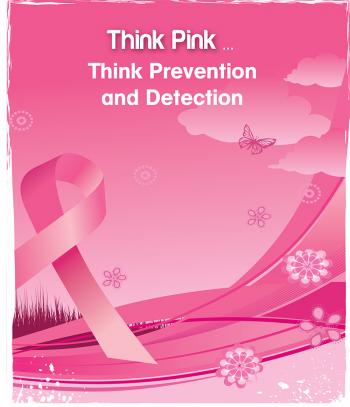
Go beyond ‘think pink’ to ‘think prevention and detection’
October is National Breast Cancer Awareness Month and “Think Pink” slogans and pink ribbons are highly visible.
Dr. Nsikan St. Martin, OB/GYN with Advanced Women’s Health, is stressing the importance of leveraging that awareness to move people into action to protect themselves and loved ones against the disease.
“Education is critical in battling breast cancer, and what’s equally crucial is taking the proper actions to reduce your risk of developing the disease,” says St. Martin. “Creating a personal early detection plan to identify your risk factors and monitor your health and scheduling annual mammograms are two things that could save your life.”
St. Martin recommends consulting with a physician to discuss individual risk factors and identify key lifestyle changes that could reduce one’s chance of getting breast cancer. In addition, people can utilize several online resources, such as the National Breast Cancer Foundation’s online risk assessment tool, to create personalized early detection plans.
The Importance
of Early Detection
According to the National Cancer Institute, when breast cancer is detected early, the five-year survival rate is 98 percent. However, more than 30 percent of women are diagnosed beyond the early detection window. This has led to higher mortality rates.
Currently for women, breast cancer is second only to lung cancer in terms of mortality. In 2011, more than 230,000 new cases of breast cancer were detected among women and more than 2,100 cases among men. Nearly 40,000 of those women (almost 20 percent) and 500 of those men (nearly 25 percent) died.
“The research regarding early detection is very encouraging. We just need to be proactive in prevention and detection,” says Dr. St. Martin. “Along with consulting their physicians, people can start by living healthy lifestyles — eating right, staying active and maintaining a healthy weight. Women also should perform breast exams at home every month and make annual exams with their gynecologists a priority. Most importantly, if you notice a change in your breast, talk to your doctor immediately.”
Women who have a digital mammogram are using the latest diagnostic technology available. Digital mammography is different from conventional mammography in how the image of the breast is acquired and, more importantly, viewed. The radiologist can magnify the images, increase or decrease the contrast and invert the black and white values while reading the images. These features allow the radiologist to evaluate microcalcifications and focus on areas of concern.
Teche Regional Medical Center in Morgan City offers a softer, warmer mammogram by using the MammoPad breast cushion for every patient. MammoPad has been clinically demonstrated to reduce discomfort, associated with mammograms, for most women. This breast cushion is “invisible” to X-rays and does not interfere with the image quality of the mammogram. By offering women a softer mammogram, the hospital hopes to increase the number of area women who follow recommendations for regular screenings.
Tips for Prevention
and Detection
Understanding the risk factors is the first step to prevention. While anyone can develop breast cancer, people displaying certain behaviors, demographics and health profiles are more prone to the disease.
These include:
—Women with a history of breast cancer have a 3- to 4-times increased risk of developing a new breast cancer, unrelated to the first one, in the other breast or in another part of the same breast.
—Women with a family history of breast cancer. Having a mother, sister or daughter who has (or has had) breast cancer increases your risk for developing the disease. The risk is even greater if your relative had cancer in both breasts or developed the breast cancer before menopause.
—Women over age 50. About 77 percent of women diagnosed with breast cancer each year are over age 50, and almost half are age 65 and older.
—Women with a previous breast biopsy result of atypical hyperplasia, or those with a previous abnormal breast biopsy indicating fibroadenomas with complex features, hyperplasia without atypia, sclerosing adenosis and solitary papilloma.
—Carriers of alterations in either of two familial breast cancer genes called BRCA1 or BRCA2.
—Caucasian women are at a slightly higher risk of developing breast cancer than are African-American, Asian, Hispanic and Native American women.
—Women who have their first child after age 35 or never have children.
—Women who started menstruating before age 12.
—Women who begin menopause after age 55.
—Overweight women, with excess caloric and fat intake (especially post-menopause).
—Women who have 2 to 5 alcoholic beverages a day are 1.5 times more likely to develop breast cancer than women who drink no alcohol.
—Those exposed to excessive amounts of radiation, especially before age 30.
—Women who use hormone replacement therapy for an extended period of time. (Risk seems to return to that of the general population after discontinuing use for five years or more.)
—Those with other cancer in the family. A family history of cancer of the ovaries, cervix, uterus or colon increases your risk of developing breast cancer.
For people who display one or more of those risk factors, it is important to understand and be able to detect the symptoms.
While breast cancer often has no symptoms in its early stages, the following symptoms may be present as a tumor develops:
—A lump in the breast or underarm that persists after your menstrual cycle.
—A marble-like area under the skin.
—Swelling in the armpit.
—Persistent breast pain or tenderness.
—Any change in the size, contour, texture or temperature of the breast.
—A noticeable flattening or indentation on the breast.
—A change in the nipple, such as an indrawn or dimpled look, itching or burning sensation, or ulceration.
—Unusual discharge from the nipple.
For more information about early detection contact your local physician or call Teche Regional Medical Center at 985-380-4400.
- Log in to post comments
